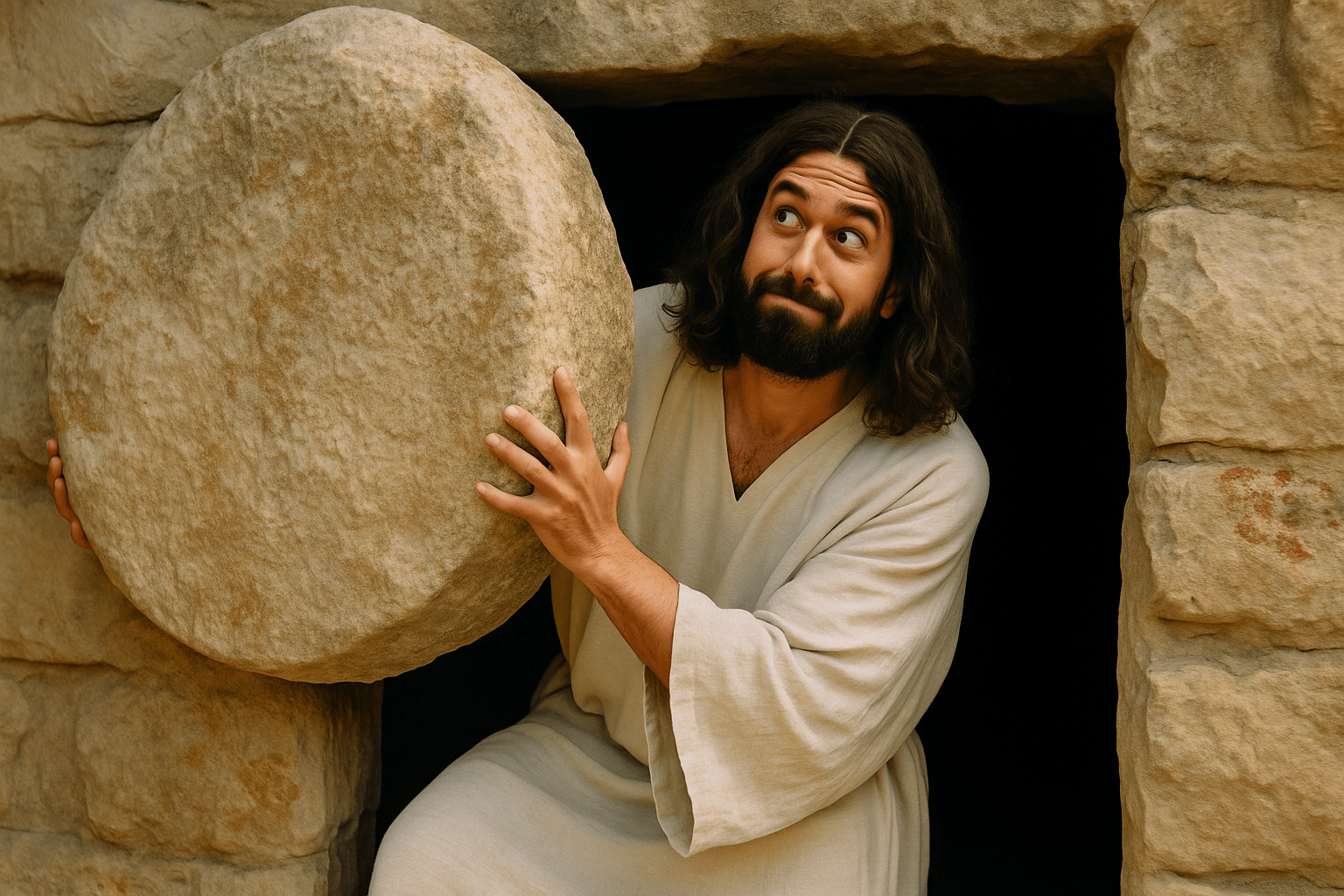Part 3 of 3 of the series Was Jesus who He said He was
Scripture Focus: 1 Corinthians 15:3–8; Acts 2:32; Matthew 28:6
“He is not here, for He has risen, just as He said.”
Matthew 28:6
Introduction: The Resurrection—or the Greatest Hoax in History?
If Jesus stayed in the tomb, Christianity is a fraud.
The Apostle Paul didn’t mince words: “If Christ has not been raised, your faith is worthless” (1 Cor. 15:17, LSB). No resurrection means no forgiveness, no hope, and no future.
But if the resurrection happened—if Jesus of Nazareth really walked out of the tomb alive—then it validates everything He claimed: His deity, His authority, and His promise of eternal life.
So what are the facts? And what are the so-called “explanations” offered by skeptics? Let’s examine the evidence—and then, let’s evaluate the excuses.
The Resurrection: Historically Credible, Theologically Central
A. The Early Creed That Changes Everything
Paul wrote to the Corinthians:
“For I delivered to you as of first importance what I also received, that Christ died for our sins… that He was buried, and that He was raised on the third day… and that He appeared”
1 Corithians 15:3–5
This isn’t just a letter—it contains one of the earliest Christian creeds, dated by scholars to within 3–5 years of the crucifixion (Hurtado, 2005, pp. 168–169). That’s not enough time for myth to grow—it’s historical memory, not theological embroidery.
Paul names eyewitnesses: Peter, James, the Twelve, and “more than five hundred” others, many of whom were still alivewhen he wrote (1 Cor. 15:6).
B. The Tomb Was Empty—and Everyone Knew It
Jesus was buried in a known tomb, owned by Joseph of Arimathea—a member of the Jewish council (Mark 15:43). This detail is inconvenient to fabricate.
On the third day, the tomb was empty. Both friend and foe agreed on this point. The Jewish leaders didn’t produce a body—they fabricated a story that the disciples stole it (Matt. 28:13). That excuse was the best they had, and frankly, it wasn’t great then—and it hasn’t aged well.
The “Ridiculous Alternatives” (Let’s Be Honest)
Let’s walk through the most common objections to the resurrection—and, with some grace and clarity, consider how little they hold up.
A. The Swoon Theory
Jesus didn’t die. He merely passed out, then revived in the cool of the tomb.
This view imagines Jesus survived the scourging, crucifixion, blood loss, and spear thrust. He was then embalmed with seventy-five pounds of spices (John 19:39), sealed in a stone tomb without food, water, or medical care—only to wake up, unwrap Himself, push aside a boulder, sneak past Roman guards, and convince His disciples He had conquered death.
This is less “historical theory” and more The Princess Bride meets Mission Impossible: Jerusalem Edition.
But consider the facts:
- Roman soldiers were professional killers. If they failed to ensure a criminal’s death, they could be executed themselves. That spear through Jesus’ side (John 19:34) wasn’t an afterthought—it was proof of death.
- The physical trauma of crucifixion—blood loss, suffocation, cardiac arrest—makes survival impossible. Modern medical experts agree (Edwards et al., 1986).
- A barely-alive man wouldn’t inspire worship. He might inspire sympathy—or horror—but not confident cries of, “My Lord and my God!” (John 20:28)
The swoon theory died long ago, and for good reason. Jesus didn’t need a medic. He needed to rise.
B. The Disciples Stole the Body
JesuThe disciples stole Jesus’ body and faked the resurrection.
This was the earliest alternative theory—and it began with a bribe (Matt. 28:11–15). The Jewish leaders paid the guards to say, “His disciples came by night and stole Him away while we were asleep.”
Let’s break that down:
- If the guards were asleep, how did they know who took the body?
- Roman guards facing a sealed tomb wouldn’t fall asleep on duty. That wasn’t “bad form”—it was a capital offense.
- More importantly, why would the disciples die for a lie?
Liars make poor martyrs. And these men weren’t expecting a resurrection (Luke 24:11). They were discouraged, fearful, and hiding. Something turned cowards into proclaimers, and doubters into martyrs. A fake resurrection doesn’t explain that. A real one does.
C. The Hallucination Theory
The appearances of Jesus were grief-induced visions or mass hallucinations.
This theory is popular in psychological circles, but it breaks down quickly—on both science and Scripture.
- Hallucinations are private, not public. You don’t get shared dreams with hundreds of people over 40 days (1 Cor. 15:6; Acts 1:3).
- Jesus appeared to groups (the Twelve, the 500), to individuals (Peter, Mary), and to a hostile skeptic (Paul). These are different contexts, times, and personality types.
- Hallucinations don’t eat breakfast (John 21:12–15), walk through walls (John 20:26), or offer their wounds to be touched (Luke 24:39; John 20:27).
Trying to reduce the resurrection to wishful thinking insults the psychological integrity of ancient people—and modern readers.
Also, let’s be honest: hallucinating Jesus might convince someone that He’s “with you in spirit.” It doesn’t explain an empty tomb.
D. The Wrong Tomb Theory
Everyone simply went to the wrong grave.
This theory assumes that multiple women (Matt. 28:1), Peter and John (John 20:4–8), the Roman guards (Matt. 27:66), and the Jewish authorities all forgot where Jesus was buried.
That’s strange—especially when His burial site belonged to a prominent man on the Jewish council (Joseph of Arimathea). People don’t misplace VIP graves in the ancient world.
Even if the women had gotten it wrong, the authorities could have simply pointed to the right tomb and said, “Here’s the body. End of story.” But they didn’t—because the tomb was, in fact, empty.
E. The Legend Theory
The resurrection was a later myth that developed over time.
This is the skeptic’s safety net: “We don’t know what happened… but the story grew over decades or centuries.”
There’s just one problem: we have early testimony.
- The resurrection creed in 1 Corinthians 15 dates to within 3–5 years of the crucifixion (Hurtado, 2005, pp. 168–169).
- The Gospels were written within a generation of the events, and circulated during the lifetimes of eyewitnesses (Bauckham, 2006, p. 264).
- Early church leaders like Clement of Rome and Ignatius affirmed the resurrection within decades, not centuries.
Legends take centuries to form. But Christianity proclaimed an empty tomb immediately, in the very city where Jesus had died. You don’t spread a legend where it can be disproven by walking to the graveyard.
Summary of the Alternatives
Here’s how the theories stack up:
| Theory | Major Problem |
|---|---|
| Swoon | Jesus couldn’t survive crucifixion and escape a tomb. |
| Stolen Body | Disciples had no motive, means, or courage—and died for it. |
| Hallucination | Doesn’t explain the empty tomb or group appearances. |
| Wrong Tomb | Authorities could have produced the body. They didn’t. |
| Legend | Too early, too fast, too rooted in eyewitness claims. |
To borrow from Sherlock Holmes: Once you eliminate the impossible, whatever remains—however improbable—must be the truth.
In this case, the improbable isn’t improbable. It’s the truth that shook the world. Jesus rose from the dead—just as He said.
The Evidence That Demands a Verdict
Here’s a brief but robust summary of the historical facts:
| Fact | Accepted by Most Scholars (including skeptics) |
|---|---|
| Jesus was crucified under Pontius Pilate | Yes (Ehrman, 2012, p. 12) |
| He was buried in a known tomb | Yes |
| The tomb was found empty | Yes (many affirm, though some dispute the cause) |
| Multiple individuals and groups saw Him alive | Yes |
| The disciples’ lives were radically transformed | Yes |
| Christianity exploded in Jerusalem—where Jesus was buried | Yes |
No other explanation accounts for all these facts. But the resurrection does. As historian N.T. Wright notes, “The best explanation for these facts is that Jesus really did rise from the dead” (Wright, 2003, p. 687).
Theological Implications: If He Rose, Then Everything Changes
The resurrection is not just a historical event—it’s a theological earthquake.
- It confirms Jesus’ identity as the Son of God (Rom. 1:4).
- It affirms that the atonement was accepted (Rom. 4:25).
- It guarantees our future resurrection (1 Cor. 15:20–22).
- It proclaims that death has been defeated (Rev. 1:18).
If Jesus is still in the tomb, your faith is in vain (1 Cor. 15:17). But if He walked out of it, then every promise He made is alive with Him.
Conclusion: The Empty Tomb Still Speaks
Christianity doesn’t rise or fall on ethics, parables, or moral teachings. It rises or falls on an empty tomb.
And the tomb is empty.
The resurrection of Jesus isn’t wishful thinking—it’s the best historical explanation of the available evidence. And it is the cornerstone of saving faith:
“If you confess with your mouth Jesus as Lord, and believe in your heart that God raised Him from the dead, you will be saved”
Romans 10:9
So the question remains—not just did He rise, but… do you believe?
References
Bauckham, R. (2006). Jesus and the Eyewitnesses: The Gospels as Eyewitness Testimony. Eerdmans.
Craig, W. L. (2008). Reasonable Faith: Christian Truth and Apologetics (3rd ed.). Crossway.
Ehrman, B. D. (2012). Did Jesus Exist? The Historical Argument for Jesus of Nazareth. HarperOne.
Hurtado, L. W. (2005). Lord Jesus Christ: Devotion to Jesus in Earliest Christianity. Eerdmans.
Wright, N. T. (2003). The Resurrection of the Son of God. Fortress Press.








